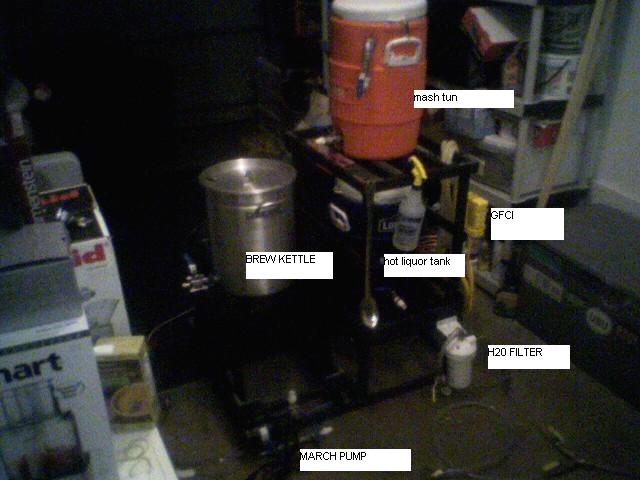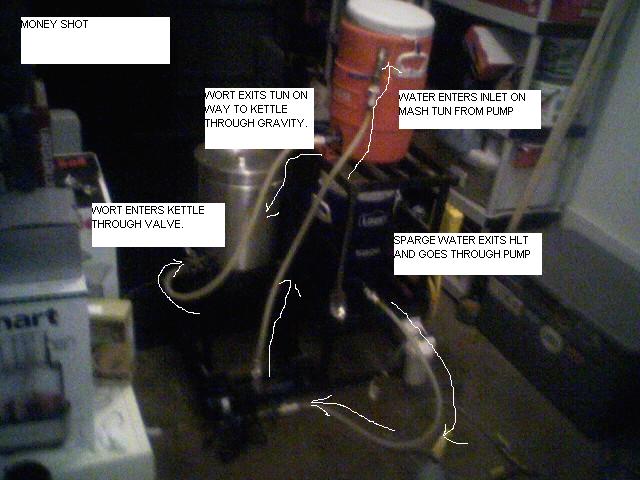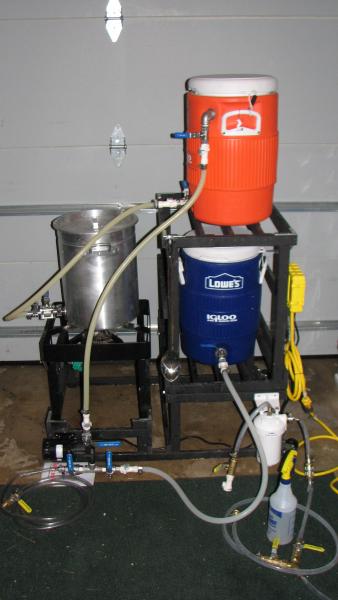I have described the process I am contemplating on building in another thread and have received good feedback, but I wanted to give this process its own thread to hopefully attract some other expert eyes just to help clarify that I am not crazy and this method is actually going to work, and work well for me. So here goes. I am going to use a typical 5 gallon batch as an example. When I list numbers and temperatures etc etc, its not important. I'd just rather say "bring the mash temp up to 152" than "depending on the specific recipe and what characteristics I hope to derive from the mash I will heat the water to the temperature I have pre-determined." And without further adieu:
This is going to be 2 10 gallon kettle, one burner, one pump, two tier system. The mash tun is going to sit on the top tier and the boil kettle/HLT on the bottom over the burner. A pump is going to connect the two so that I can pump liquid from the HLT up to the mash tun and the tun will be able to return/recirculate the water back down to the HLT by using gravity.
1) Heat 8 gallons of water in the HLT to 168. 8 gallons is the total amount of water I will be using for the batch.
2) Pump roughly 4 gallons of water over to the mash tun, add grains, stir etc.
3) Begin recirculating wort from the mash tun to the HLT and back again. At this point all 8 gallons of water is slowly moving through the mash. This process should take roughly one hour as any typical mash. I will determine when its finished by taking refractometer samples periodically from the HLT. It is complete when my target OG has been reached.
4) I will have pre-calculated the grain absorption and when I turn off the recirculating pump the water should completely drain from the mash tun and leave me with 6 gallons of hot wort. There is no need for vorlaufing, I have been doing that the entire time!
5) I will bring the wort up to boiling and proceed with the rest of the boil.
So in other words I am eliminating the need to batch sparge by implementing a no sparge/fly sparge type technique and I am utilizing only one burner and one pump as well as saving additional time on vorlaufing by recirculating the wort through both kettles. I actually assume I will have better efficiency that a batch sparge method. Its basically the brutus 20 method, except I am not doing a standard mash, and the liquid will be recirculating through both pots the entire time so I can save myself from needing two burners and pumps. So am I crazy, will this actually work?
This is going to be 2 10 gallon kettle, one burner, one pump, two tier system. The mash tun is going to sit on the top tier and the boil kettle/HLT on the bottom over the burner. A pump is going to connect the two so that I can pump liquid from the HLT up to the mash tun and the tun will be able to return/recirculate the water back down to the HLT by using gravity.
1) Heat 8 gallons of water in the HLT to 168. 8 gallons is the total amount of water I will be using for the batch.
2) Pump roughly 4 gallons of water over to the mash tun, add grains, stir etc.
3) Begin recirculating wort from the mash tun to the HLT and back again. At this point all 8 gallons of water is slowly moving through the mash. This process should take roughly one hour as any typical mash. I will determine when its finished by taking refractometer samples periodically from the HLT. It is complete when my target OG has been reached.
4) I will have pre-calculated the grain absorption and when I turn off the recirculating pump the water should completely drain from the mash tun and leave me with 6 gallons of hot wort. There is no need for vorlaufing, I have been doing that the entire time!
5) I will bring the wort up to boiling and proceed with the rest of the boil.
So in other words I am eliminating the need to batch sparge by implementing a no sparge/fly sparge type technique and I am utilizing only one burner and one pump as well as saving additional time on vorlaufing by recirculating the wort through both kettles. I actually assume I will have better efficiency that a batch sparge method. Its basically the brutus 20 method, except I am not doing a standard mash, and the liquid will be recirculating through both pots the entire time so I can save myself from needing two burners and pumps. So am I crazy, will this actually work?

















































![Craft A Brew - Safale S-04 Dry Yeast - Fermentis - English Ale Dry Yeast - For English and American Ales and Hard Apple Ciders - Ingredients for Home Brewing - Beer Making Supplies - [1 Pack]](https://m.media-amazon.com/images/I/41fVGNh6JfL._SL500_.jpg)











